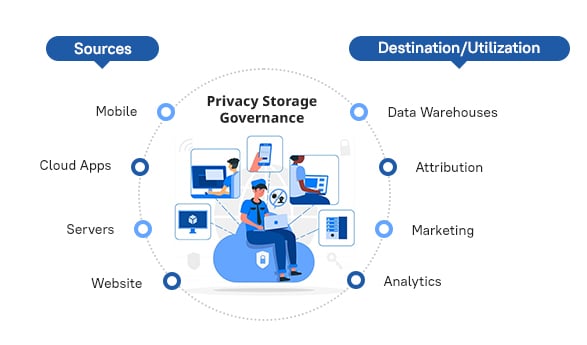In a rapidly evolving business landscape, data fuels critical decision-making and ensures smooth organizational operations. According to a report by Statista, projections for the years 2020-2025 anticipate that global data creation and replication will exceed 180 zettabytes. The report revealed that in 2020, the total volume of generated and replicated data reached unprecedented levels, largely influenced by the effects of the COVID-19 pandemic. However, only two percent of the data produced and consumed in 2020 was saved in 2021, given storage capacity challenges. This is expected to experience a compound annual growth rate of 19.2 percent from 2020 to 2025.
As the exponential growth of global data creation continues to shape the modern business landscape, the need for effective data management becomes increasingly evident. Data mapping in integration involves aligning data fields between different systems to ensure seamless communication. Transformation is the process of converting data from one format to another, ensuring compatibility and consistency. For an IT business owner, it is the key to streamlined operations, enhanced decision-making, and improved overall performance.
The Importance of Data Mapping
Data integration is at the heart of efforts made to harness data power, ensuring that disparate data sources can communicate and share information effectively. Within the context of data integration, data mapping and data transformation are crucial concepts playing a pivotal role.
- They are the indispensable components of any successful data integration strategy.
- They enable businesses to bridge the gap between various data sources, formats, and structures, ensuring that information flows smoothly across systems.
Seamless Data Exchange: Data mapping helps establish a common language between different systems by defining how data from one source corresponds to data in another. Transformation, on the other hand, ensures that data is converted into a consistent format, making it accessible and usable for downstream applications.
Improved Decision-Making: Accurate and timely data is essential for informed decision-making. Effective data mapping and transformation helps businesses provide decision-makers with crucial information regarding business operations, leading to better insights and strategic choices.
Enhanced Customer Experience: Ensuring smooth exchange of data between clients’ systems is vital to most businesses. However, the formats may not always be aligned, leading to data chaos or inaccessibility to critical information. Data mapping and transformation enable the integration of software applications, resulting in a seamless customer experience and increased customer satisfaction.
Understanding Data Mapping
Data mapping is the process of defining how data elements in one system correspond to data elements in another system. It serves as a blueprint, guiding data integration efforts and ensuring that data from different sources align correctly.
Some key aspects of data mapping include:
- Data Source Identification: Identifying the source of data and understanding its structure is the first step in data mapping. This involves comprehending the data fields, their meanings, and any potential variations or inconsistencies.
- Field Mapping: Once the source data is understood, the next step is to create data mapping that specifies how each data field in the source corresponds to a field in the target system. This includes defining data types, transformation rules, and any other necessary validations.
- Data Relationships: Data mapping considers relationships between different data elements, which is essential for maintaining data integrity during integration.
Steps Involved in the Data Mapping Process
- Conduct a comprehensive analysis to identify data fields requiring mapping
- Ensure consistency in naming conventions across various sources
- Develop data transformation rules and schema logic to facilitate seamless integration
- Thoroughly test the established logic to validate accuracy and reliability
- Execute migration, integration, or transformation once testing concludes successfully

Navigating Data Journey
Explore the seamless flow of data from diverse sources like mobiles and cloud apps to strategic destinations such as data warehouses and analytics platforms. Alongside, prioritize privacy, storage, and governance for a secure and efficient voyage.
Understanding Transformation
Data transformation complements data mapping by ensuring that data is converted into the desired format and structure during integration. This process involves several key elements:
Data Cleansing: Often, data from different sources may contain inconsistencies, errors, or duplicates. Data transformation can involve data cleansing techniques to standardize and clean data before integration.
Data Enrichment: In some cases, data may need to be enriched with additional information or calculations to meet the requirements of the target system or application.
Format Conversion: Data transformation can also involve converting data from one format to another, such as changing dates from one standard to another or converting units of measurement.
Data Mapping and Transformation in Integration
Data integration is the process of combining data from disparate sources into a unified and meaningful view. Data mapping and transformation are integral to this process, ensuring that data is accurately and coherently integrated. Here’s how these concepts come together in data integration for IT solution providers:
Data Source Integration: IT solutions frequently require connectivity with a variety of data sources, encompassing databases, APIs, files, and cloud services. Data mapping is used to understand the structure of these sources, while transformation ensures that the data is transformed into a consistent format.
Data Transformation Pipeline: Data may need to go through a series of transformations before it can be integrated into the target system. This could involve aggregating data, filtering out irrelevant information, or performing calculations. Data transformation pipelines are designed to handle these tasks efficiently.
Real-Time Integration: In today’s fast-paced business environment, real-time data integration is crucial. Data mapping and transformation must be performed in real time to ensure that the most up-to-date information is available for decision-making and customer interactions.
Partnering Right: The Significance of Relevant Data Mapping Tools and Technology
How to do data mapping? What are some of the data mapping techniques to employ? What about the relevant data mapping tools?
These are some of the questions for organizations looking to leverage data mapping for their business purposes.
Given the crucial role played by data mapping and transformation in enhancing customer experiences and driving efficiency, it is vital to ensure the right tools and technology are deployed. Expert insights can help businesses optimize the efforts invested in data mapping processes and the overall data mapping method. Partnering with an expert can help businesses navigate the complex landscape of data integration, ensuring smooth and streamlined flow of data across systems. Experts also have access to the latest in terms of tech capabilities and data mapping automation. Leveraging this rich resource system can prove beneficial to businesses looking to harness data power.
A wide range of data mapping tools and technologies facilitate the process within a business organization. These specialized data mapping tools streamline the integration process, enhance efficiency, and ensure accuracy. Some notable tools and technologies include:
Integration Platforms: Integration platforms provide comprehensive solutions for data mapping and transformation. They offer pre-built connectors, data transformation capabilities, and monitoring tools to streamline integration efforts.
Extract, Transform, Load (ETL) Tools: ETL tools are designed specifically for data transformation. They enable businesses to extract data from various sources, transform it as needed, and load it into target systems efficiently.
API Gateways: API gateways enable the integration and management of APIs by facilitating data transformation, security, and access control.
Data Integration Platforms: For businesses dealing with large volumes of data, data integration platforms can offer robust data mapping and transformation capabilities.
Custom Development: In cases where needed, custom development may be necessary to create bespoke data mapping and transformation solutions tailored to unique business requirements.
To conclude, businesses cannot ignore the significance of data mapping and data organization in an increasingly data-driven world. Given the wide choices available in data mapping tools and technologies, it is crucial for organizations to zoom into those that align best with organizational processes and growth goals. Leveraging expertise for assistance with data mapping can go a long way in furthering business growth goals.
Interested in learning more? Unlock the potential for unprecedented business growth by partnering with our seasoned web application development experts. Experience profitability and innovation hand in hand. Reach out to us now at sales@analytix.com or give us a call at 781.503.9003 if you have any queries.
